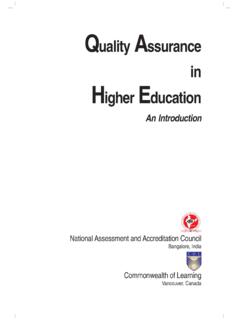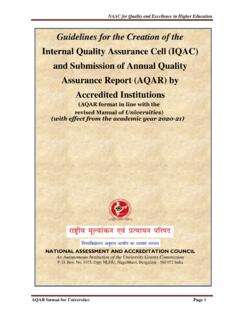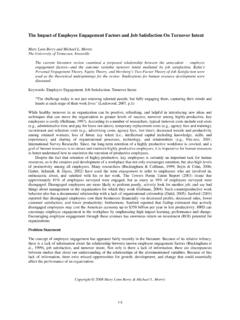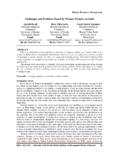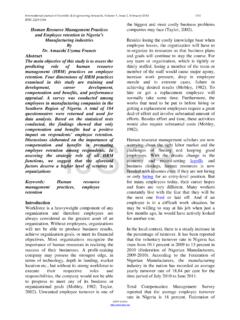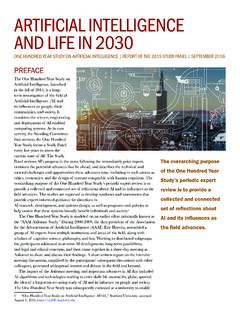Transcription of NAAC 12
1 NAAC for Quality and Excellence in Higher Education 12. Manual for Universities PREFACE. It is heartening that National Assessment and Accreditation Council (NAAC). has brought in new spirit into its process of assessment and accreditation. This has been attempted as a continuance of the NAAC s concern for ensuring that its processes are in tune with local, regional and global changes in higher education scenario. The main focus of the revision process has been to enhance the redeeming features of the accreditation process and make them more robust, objective, transparent and scalable as well as make it ICT enabled. It also has reduced duration of accreditation process. The revised process is an outcome of the feedback received by NAAC over a long period through various Consultative Meetings, Expert Group Meetings, which comprised of eminent academicians representing the University and College sectors.
2 In addition, the NAAC also solicited feedback through the web from the stakeholders and specifically from the academia during the Assessors Interaction Meetings (AIM). The entire revision exercise has successfully resulted in the development of an assessment and accreditation framework which is technology enabled and user friendly. Higher Education Institutions (HEIs) desirous of seeking accreditation from now on will need to understand the changes made in the process. Keeping this in mind, the Manuals have been revised separately for Universities, Autonomous Colleges and Affiliated/Constituent Colleges. The Self- Study Report (SSR) forms the backbone of the entire process of accreditation. Special effort has been made to differentiate some of the items to render them more applicable to different categories of institutions. It is hoped that the Manuals will help the HEIs to prepare for the revised process of assessment and accreditation.
3 As always, NAAC welcomes feedback from every corner. In an effort to enhance the accountability of the accrediting agency as well as the institutions applying for accreditation, it is advised to look into the latest developments on the website of NAAC. The contribution of the experts and NAAC officials/staff in developing the Manual is gratefully acknowledged. December, 2019. Bengaluru (Dr. S. C. Sharma). Director, NAAC. NAAC for Quality and Excellence in Higher Education 2. Manual for Universities CONTENTS Page No. Preface 2. SECTION A: Guidelines for Assessment and Accreditation I. Introduction 5. Vision and Mission 5. Core Values 6. II. Assessment and Accreditation of Higher Education Institutions 8. Revised Assessment and Accreditation (A&A) Framework 8. Focus of Assessment 9. III. Quality Indicator Framework (QIF) - Description 9. IV. Eligibility for Assessment and Accreditation by NAAC 22.
4 V. The Assessment Process 23. VI. Procedural Details 26. VII. Assessment Outcome 29. Calculation of Institutional CGPA 29. VIII. Mechanism for Institutional Appeals 30. IX. Re-Assessment 31. X. Subsequent Cycles of Accreditation 31. XI. Fee Structure and other Financial Implications 32. XII. Getting Ready for Submission of Self - Study Report (SSR) 35. XIII. Mandatory Disclosure on HEI's Website 36. SECTION B: Data Requirements for Self - Study Report (SSR). 1. Executive Summary 38. 2. Profile of the University 39. 3. Extended Profile of the University 45. 4. Quality Indicator Framework (QIF) 47. 5. Evaluative report of the Departments 99. 6. Data Templates/Documents (Quantitative Metrics) 100. SECTION C: Appendices 1. Appendix 1: Glossary and Notes 128. 2. Appendix 2: Abbreviations 141. NAAC for Quality and Excellence in Higher Education 3. Manual for Universities SECTION A: GUIDELINES FOR ASSESSMENT AND.
5 ACCREDITATION. This Section presents the NAAC framework for Assessment and Accreditation based on the Core Values and Criteria for assessment and Key Indicators. Further, it details out the procedures for institutional preparation for filling the Self Study Report online, Peer Assessment and the final Outcome of Accreditation. The procedure for re-assessment, mechanism for institutional appeals and accreditation of subsequent cycles are also presented. NAAC for Quality and Excellence in Higher Education 4. Manual for Universities I. INTRODUCTION. India has one of the largest and diverse education systems in the world. Privatization, widespread expansion, increased autonomy and introduction of Programmes in new and emerging areas have improved access to higher education. At the same time, it has also led to widespread concern on the quality and relevance of the higher education.
6 To address these concerns, the National Policy on Education (NPE, 1986) and the Programme of Action (PoA, 1992) spelt out strategic plans for the policies, advocated the establishment of an independent National accreditation agency. Consequently, the National Assessment and Accreditation Council (NAAC) was established in 1994 as an autonomous institution of the University Grants Commission (UGC) with its Head Quarter in Bengaluru. The mandate of NAAC as reflected in its vision statement is in making quality assurance an integral part of the functioning of Higher Education Institutions (HEIs). The NAAC functions through its General Council (GC) and Executive Committee (EC). comprising educational administrators, policy makers and senior academicians from a cross- section of Indian higher education system. The Chairperson of the UGC is the President of the GC of the NAAC, the Chairperson of the EC is an eminent academician nominated by the President of GC (NAAC).
7 The Director is the academic and administrative head of NAAC and is the member-secretary of both the GC and the EC. In addition to the statutory bodies that steer its policies and core staff to support its activities NAAC is advised by the advisory and consultative committees constituted from time to time. Vision and Mission The vision of NAAC is: To make quality the defining element of higher education in India through a combination of self and external quality evaluation, promotion and sustenance initiatives. The mission statements of the NAAC aim at translating the NAAC s vision into action plans and define NAAC s engagement and endeavor as given below: To arrange for periodic assessment and accreditation of institutions of higher education or units thereof, or specific academic programmes or projects; . To stimulate the academic environment for promotion of quality in teaching-learning and research in higher education institutions.
8 To encourage self-evaluation, accountability, autonomy and innovations in higher education; . To undertake quality-related research studies, consultancy and training programmes, and . To collaborate with other stakeholders of higher education for quality evaluation, promotion and sustenance.. Striving to achieve its goals as guided by its vision and mission statements, NAAC primarily focuses on assessment of the quality of higher education institutions in the country. The NAAC. methodology for Assessment and Accreditation is very much similar to that followed by Quality Assurance (QA) agencies across the world and consists of self-assessment by the institution along with external peer assessment organized by NAAC. NAAC for Quality and Excellence in Higher Education 5. Manual for Universities Core Values Throughout the world, Higher Education Institutions (HEIs) function in a dynamic environment.
9 The need to expand the system of higher education, the impact of technology on the educational delivery, the increasing private participation in higher education and the impact of globalization (including liberal cross-border and trans-national educational imperatives), have necessitated marked changes in the Indian higher education system. These changes and the consequent shift in values have been taken into cognizance by NAAC while formulating the core values. Accordingly, in order to ensure external and internal validity and credibility, the QA. process of NAAC is grounded within a value framework which is suitable and appropriate to the National context. The accreditation framework of NAAC is thus based on five core values detailed below. (i) Contributing to National Development Most of the HEIs have a remarkable capacity to adapt to changes and at the same time, pursue the goals and objectives that they have set forth for themselves.
10 Contributing to national development has always been an implicit goal of Indian HEIs. The role of HEIs is significant in human resource development and capacity building of individuals, to cater to the needs of the economy, society and the country as a whole, thereby, contributing to the development of the Nation. Serving the cause of social justice, ensuring equity and increasing access to higher education are a few ways by which HEIs can contribute to the national development. It is therefore appropriate that the Assessment and Accreditation (A&A) process of NAAC looks into the ways HEIs have been responding to and contributing towards national development. (ii) Fostering Global Competencies among Students The spiraling developments at the global level also warrant that the NAAC includes in its scope of assessment skill development of students, on par with their counterparts elsewhere in the world.


